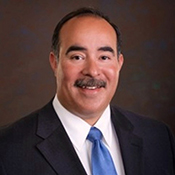
(Photo Credit: UCR)
Paul Granillo is the president and CEO of the Inland Empire Economic Partnership and has been a strong voice for developing a triple bottom line approach to economic development—-one that creates more sustainable middle-class jobs for all Californians. Mr. Granillo is also a former co-chair of the California Economic Summit Steering Committee.
When I adopted the term “Two California’s” several years ago, it reflected the frustration that some of us who live outside California's coastal “boom areas” have.
As a proud product of the Inland Empire—an area that has more than 10 percent of California's population—I wanted to make sure that we weren't forgotten as important discussions and resulting policies were created in the name of statewide economic development.
I'm happy and a little proud that the California Economic Summit—which we've supported since its inception six years ago—has embraced addressing the yawning gap that exists in California—-a state with great prosperity and paralytic poverty.
I would argue that the Summit—like the rest of us—needs to up its game. The Summit priorities of improving workforce, expanding housing and saving water must be imperatives. The term “Elevate CA” describes the situation perfectly. We need action that leads to results that can lift up some portion of the 18 million Californians who live in or near poverty.
Let me look ahead for a moment—15 years in the future. My five-year old daughter will be 20 and I'll be ready for Medicare. What it will be like in the Inland Empire? It better be different. Right now, for the 4.5 million people who live here we have only two four-year public universities schools—UC Riverside and Cal State Bernardino.
Education is a key to addressing the economic insecurity that plagues our state—and our region where only 20 percent have earned bachelor degrees (less than half of those in Silicon Valley).
While we are enjoying a surge in job creation—second most of any region in the state—we also know the rise of the robots is underway and many of our blue collars in manufacturing and logistics will disappear.
Our population will continue to grow to an estimated 7.5 million people by 2045. The majority of the growth in California will most likely be inland because housing is cheaper here. They'll need jobs, homes and water.
So, the Summit is working on the right things—one million more trained workers, one million more housing units and saving one million-acre feet of water per year.
Let me suggest some other things that need to happen to achieve those goals.
1. In the Inland Empire, we need a larger higher education presence—rather than asking for more public universities to be built from scratch, we believe that expanding both UC Riverside and Cal State San Bernardino would be a more effective approach. What’s needed is money for capital expansion at both universities as well as continued enrollment growth money from the state.
2. The Strong Workforce Program of the California Community Colleges simply must succeed—we must ensure that community college students receive not only just an associates degree but are properly prepared for a JOB. Strong Workforce is the most relevant program the community colleges have developed in my memory—and resistance both inside and outside of the college system must be vanquished.
3. Employers have to get involved. It's easy to say that the educational system is not providing them with the workers they need—stop complaining, get involved with the local schools and work with them to develop the courses they need to give you the workers you need.
If you are feeling urgency in my comments—good.
 I spend a lot of time thinking about my daughter and her future. I know that many of the jobs she'll be competing for in 15-20 years haven't even been invented yet. I hope she and millions like her will be ready.
I spend a lot of time thinking about my daughter and her future. I know that many of the jobs she'll be competing for in 15-20 years haven't even been invented yet. I hope she and millions like her will be ready.
In the meantime, those 18 million Californians who live in or near poverty want a piece of the California Dream too. Elevating as many of them as possible into the middle class as soon as possible is an imperative.

